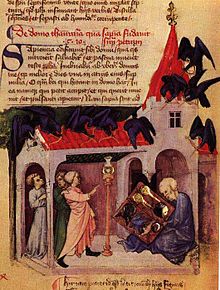Aurora consurgens

Aurora consurgens ( Latin : 'rising dawn') is the title of an alchemistic treatise from the 15th century (around 1420), which is completely unique in terms of style and content. Often, Aurora Consurgens the Thomas Aquinas attributed to what is controversial. Not least, the dissimilar style speaks against his authorship (with one exception: the style and content of the fourth parable correspond to the Expositio in Symbolum Apostolorum - an oral lecture by Thomas Aquinas).
According to von Franz, the following indications speak for the authorship of Thomas Aquinas : The author of the Aurora shows great familiarity with the Holy Scriptures and the liturgy, cites only relatively few of the classic alchemical treatises and no chemical recipes or technical regulations. This speaks for a cleric; the praise of the "pauperes" (poor) for a Dominican or Franciscan. The text gives the impression of passionate emotion and - written as the result of an invasion of the unconscious, according to psychological experience - could have compensated for an otherwise very intellectual and logic-dominated consciousness. Thomas von Aquin's biography fits this pattern: it suggests a tense, very introverted personality with deep inner experiences, with highly differentiated thinking while suppressing the natural demand for feeling (this assessment is based on the psychological type theory of CG Jung). Before his death Thomas Aquinas had a disturbing great vision, the content of which has not been authenticated, but he is said to have interpreted the Song of Songs on his deathbed. Possibly the treatise is a reproduction of his last seminar or his last words (possibly further elaborated by others).
The treatise is best known for its 38 watercolor pictures. The picture shown here with the birds on the church shows, according to Abbot, a close relationship to an older illustration of Ibn Umail's Arabic alchemical book about silver water and the starry earth . This representation from the Aurora Consurgens can be regarded as the oldest European representation of an important vision of Ibn Umail, assimilated to the Christian context. Later, the motif of the wise man sitting in a church with birds with a blackboard or a book in his hands was also received and again changed in the Theatrum Chemicum (Strasbourg 1660) and JJ Mangetus Bibliotheca Chemica (Geneva 1702).
Manuscripts are u. a. in the Staatsbibliothek zu Berlin (MS. Germ. qu. 848. = Bl. 1r Die vffgehnde Morgenrödte), Zentralbibliothek Zürich (MS. Rhenoviensis 172), Glasgow University Library (MS. Ferguson 6), in Leiden (MS. Vossiani Chemici F . 29), Bibliothèque nationale de France Paris (MS. Parisinus Latinus 14006) and the library of Charles University in Prague (MS. VI. Fd. 26).
Trivia
The power metal band Angra in 2006 published a treatise inspired by this album.
literature
- Marie-Louise von Franz : Aurora consurgens. A document on the alchemical problem of opposites attributed to Thomas Aquinas. In: Carl G. Jung : Mysterium coniunctionis. Investigation of the separation and composition of the mental opposites in alchemy. Volume 3 (supplementary volume) ( Psychological Treatises 12, ZDB -ID 504202-1 ), Rascher, Zurich u. a. 1957. Edited as Volume 14/3 of Jung's Collected Works - (Translation, historical and psychological commentary by Aurora consurgens)
- G. Meyrink: Thomas Aquinas treatise on the philosopher's stone . Munich / Vienna 1925.
Remarks
- ↑ Ms. Rh. 172, fol. 3r-7, Zurich Central Library.
- ↑ In the manuscript Silberwasser und Sternenerde ; Illustration is shown and annotated in: Theodor Abt: Book of the Explanation of the Symbols. Kitāb Ḥall ar-Rumūz. Psychological Commentary by Theodor Abt . Corpus Alchemicum Arabicum (CALA) 1B, Living Human Heritage Publications, Zurich 2009. pp. 15-18, 59-64.
- ↑ E. v. Lippmann, History of Alchemy Volume II. Springer, Berlin 1931, p. 28. Quoted in Marie-Louise von Franz :: Aurora Consurgens. A document on the alchemical problem of opposites attributed to Thomas Aquinas (1957). In: CG Jung: Gesammelte Werke 14.3 , Walter, Düsseldorf 1995, ISBN 3-530-40091-2 , p. 209, footnote 3 (Chapter: Is Thomas Aquinas the author? ).
- ↑ Quoted from Marie-Louise von Franz: Aurora Consurgens. A document on the alchemical problem of opposites attributed to Thomas Aquinas (1957). In: CG Jung: Collected Works 14.3. Walter, Düsseldorf 1995, ISBN 3-530-40091-2 , p. 433 with footnote 133 on the authenticity of the writing. (Chapter: Is Thomas Aquinas the author? ).
- ^ Marie-Louise von Franz: Aurora Consurgens. A document on the alchemical problem of opposites attributed to Thomas Aquinas (1957). In: CG Jung: Collected Works 14.3. Walter, Düsseldorf 1995, ISBN 3-530-40091-2 , pp. 407-408.
- ^ Marie-Louise von Franz: Aurora Consurgens. A document on the alchemical problem of opposites attributed to Thomas Aquinas (1957). Walter, Düsseldorf 1995, p. 409.
- ^ Marie-Louise von Franz: Aurora Consurgens. A document on the alchemical problem of opposites attributed to Thomas Aquinas (1957). Walter, Düsseldorf 1995, p. 424f.
- ^ Marie-Louise von Franz: Aurora Consurgens. A document on the alchemical problem of opposites attributed to Thomas Aquinas (1957). Walter, Düsseldorf 1995, pp. 432-434.
- ^ Theodor Abt: Book of The Explanation of the Symbols. Kitab Hall ar-Rumuz by Muhammad ibn Umail. Psychological Commentary by Theodor Abt. Corpus Alchemicum Arabicum Volume IB. Living Human Heritage, Zurich 2009, ISBN 978-3-9522608-8-3 , pp. 59-64.
- ↑ Published as Volume III of Jung's "Mysterium Coninuctionis" as an illustration of the representation of the alchemical problem of opposites there; Joint publication in one work, since "both authors were also involved in the work of the other", as Jung writes in the foreword to volume Mysterium coniunctionis Volume I (p. 14 of "Gesammelte Werke Volume 14/1" Walter, Düsseldorf 1995, ISBN 3-530-40090-4 ).
Web links
- Berlin, State Library, mgq 848 on manuscripta-mediaevalia.de
- Berlin, State Library, mgq 848 in the manuscript census
- Leiden, University Library, Ms. Vossianus Chemicus F. 29 on digital sources (do not enter a direct link to Ms. for "simple search" "aurora consurgens")
- Zurich Central Library, Ms. Rh. 172 on e-codices



